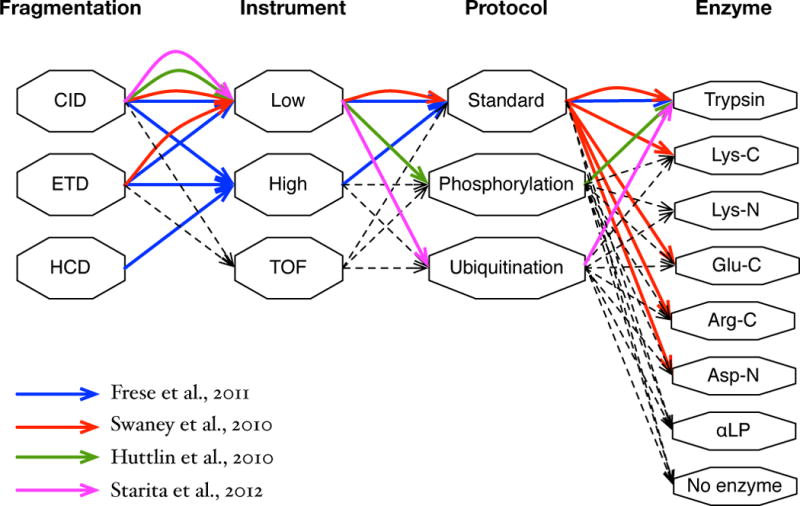Figure 1.

Various spectral types. Spectral types are represented as paths in the graph representing possible choices of the fragment method (Fragmentation), the instrument measuring product ion m/z (Instrument), the protocol used to prepare a sample (Protocol), and the enzyme used to digest proteins (Enzyme). ‘Low’ in Instrument indicates low-resolution instruments (e.g. linear ion-trap), ‘High’ indicates high-resolution instruments (e.g. Orbitrap), and ‘TOF’ indicates time-of-flight instruments. ‘Phosphorylation’ and ‘Ubiquitination’ in Protocol indicate that spectra are generated from phosphopeptides and ubiquitinated peptides, respectively. A path in the graph represents a spectral type. For example, the green path (CID, Low, Phosphorylation, Trypsin) represents low-precision CID spectra of trypsin digests generated from a sample enriched for phosphopeptides. The blue, red, green, and magenta paths represent spectral types of the datasets used in recent studies by Frese et al. [20], Swaney et al. [1], Huttlin et al. [21], and Starita et al. [22], respectively. Different combinations of analysis tools were used for different studies. Frese et al. used an in-house tool for peak filtering, de-isotoping, and charge deconvolution, Mascot for database search, Percolator for re-scoring, and RockerBox [58] for peptide-level FDR control. Swaney et al. used an in-house tool for peak filtering, OMSSA [27] for database search, and an in-house tool for both peptide- and protein-level FDR control. Huttlin et al. used an in-house tool for re-calibrating peak masses, SEQUEST for database search, an in-house tool for re-scoring, and peptide- and protein-level FDR control. Starita et al. used the Trans-Proteomics Pipeline [45] along with SEQUEST for database search. The same datasets were analyzed by MS-GF+ without using any additional tool with scoring parameters trained separately for different spectral types.
